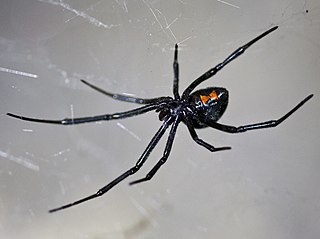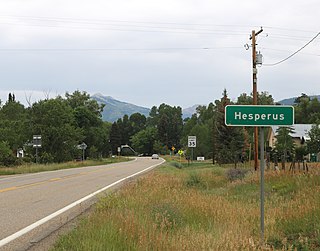
Latrodectus is a broadly distributed genus of spiders with several species that are commonly known as the true widows. This group is composed of those often loosely called black widow spiders, brown widow spiders, and similar spiders. However, the diversity of species is much greater. A member of the family Theridiidae, this genus contains 34 species, which include several North American "black widows". Besides these, North America also has the red widow Latrodectus bishopi and the brown widow Latrodectus geometricus, which, in addition to North America, has a much wider geographic distribution. Elsewhere, others include the European black widow, the Australian redback spider and the closely related New Zealand katipō, several different species in Southern Africa that can be called button spiders, and the South American black-widow spiders. Species vary widely in size. In most cases, the females are dark-coloured and can be readily identified by reddish markings on the central underside (ventral) abdomen, which are often hourglass-shaped.

HMS Hesperus was an H-class destroyer that had originally been ordered by the Brazilian Navy with the name Juruena in the late 1930s, but was purchased by the Royal Navy after the beginning of World War II in September 1939, commissioned in 1940 as HMS Hearty and then quickly renamed as Hesperus.

In Greek mythology, Hesperus is the Evening Star, the planet Venus in the evening. A son of the dawn goddess Eos, he is the half-brother of her other son, Phosphorus. Hesperus' Roman equivalent is Vesper. By one account, Hesperus' father was Cephalus, a mortal, while Phosphorus was the star god Astraios. Other sources, however, state that Hesperus was the brother of Atlas, and thus the son of Iapetus.

"The Wreck of the Hesperus" is a narrative poem by American poet Henry Wadsworth Longfellow, first published in Ballads and Other Poems in 1842. It is a story that presents the tragic consequences of a skipper's pride. On an ill-fated voyage in winter, he brings his daughter aboard ship for company. The skipper ignores the advice of one of his experienced men, who fears that a hurricane is approaching. When the storm arrives, the skipper ties his daughter to the mast to prevent her from being swept overboard. She calls out to her dying father as she hears the surf beating on the shore, then prays to Christ to calm the seas. The ship crashes onto the reef of Norman's Woe and sinks; the next morning a horrified fisherman finds the daughter's body, still tied to the mast and drifting in the surf. The poem ends with a prayer that all be spared such a fate "on the reef of Norman's Woe."

Phosphorus is the god of the planet Venus in its appearance as the Morning Star. Another Greek name for the Morning Star is "Eosphorus", which means "dawn-bringer". The term "eosphorus" is sometimes met in English. As an adjective, the word "phosphorus" is applied in the sense of "light-bringing" and "torch-bearing" as an epithet of several gods and goddesses, especially of Hecate but also of Artemis/Diana and Hephaestus. Seasonally, Venus is the "light bringer" in the northern hemisphere, appearing most brightly in December, signalling the "rebirth" of longer days as winter wanes.
Mount Hesperus is the highest peak of the Revelation Mountains, the westernmost subrange of the Alaska Range. The Revelations are a small, rarely visited range, but they contain dramatic rock peaks, rising from low bases. Mount Hesperus is particularly impressive in terms of local relief: for example, it drops over 7,500 feet (2,286m) in less than 2 miles (3,219m) on two sides. Such steepness for this amount of relief makes Hesperus comparable to the best peaks in North America.

Hesperus Mountain is the highest summit of the La Plata Mountains range of the Rocky Mountains of North America. The prominent 13,237-foot (4,035 m) thirteener is located in San Juan National Forest, 13.2 miles (21.2 km) northeast by east of the Town of Mancos in Montezuma County, Colorado, United States. The summit of Hesperus Mountain is the highest point in Montezuma County.

Latrodectus hesperus, the western black widow spider or western widow, is a venomous spider species found in western regions of North America. The female's body is 14–16 mm in length and is black, often with an hourglass-shaped red mark on the lower abdomen. This "hourglass" mark can be yellow, and on rare occasions, white. The male of the species is around half this length and generally a tan color with lighter striping on the abdomen. The population was previously described as a subspecies of Latrodectus mactans and it is closely related to the northern species Latrodectus variolus. The species, as with others of the genus, build irregular or "messy" webs: unlike the spiral webs or the tunnel-shaped webs of other spiders, the strands of a Latrodectus web have no apparent organization.

Hesperus is an unincorporated community and a U.S. Post Office in La Plata County, Colorado, United States. The Hesperus Post Office has the ZIP Code 81326.

The canyon bat, also known as the western pipistrelle, or American parastrelle is a species of vesper bat. It is found in Mexico and in the western United States. The species has historically been placed in the genus Pipistrellus, but molecular evidence does not show any close relationship with that genus, and accordingly it was classified into its own genus, Parastrellus, in 2006.

The La Plata Mountains are a small subrange of the San Juan Mountains in the southwestern part of Colorado, United States. They are located on the border between Montezuma and La Plata counties, about 12 miles (19 km) northwest of Durango. Their name is Spanish for silver.
Hesperus Press is an independent publishing house based in London, United Kingdom. It was founded in 2001. The publisher's motto, "Et Remotissima Prope," is a Latin phrase which means "Bringing near what is far". Hesperus Press has published some 300 works by both classic and contemporary authors, including: Dante, Percy Bysshe Shelley, Dickens, Dostoyevsky, Flaubert, Kafka, Tolstoy, Woolf, Annie Dillard, and Aldous Huxley. Their series include: Hesperus Classics, Brief Lives, Poetic Lives, ON, Modern Voices, and Hesperus Worldwide. Hesperus is also responsible for the best-seller The Hundred-Year-Old Man Who Climbed Out the Window and Disappeared by Swedish author Jonas Jonasson, released in July 2012.

Papilio hesperus, the black and yellow swallowtail or Hesperus swallowtail, is a butterfly of the family Papilionidae. It is found in Africa. It is monomorphic, meaning there is only one phenotype in the population of this species. The dorsal and ventral sides of its wings are practically identical due to the wing's translucence.
SC 129 was a North Atlantic convoy of the SC series which ran during the Battle of the Atlantic in World War II. It was one of several convoy battles that occurred during the crisis month of May 1943.

The Wreck of the Hesperus is a 1927 American silent film based on the famous poem. It was an early screenplay credit for later film director John Farrow.

Pogonocherini is a tribe of longhorn beetles of the subfamily Lamiinae.
Poliaenus is a genus of longhorn beetles of the subfamily Lamiinae, containing the following species:
Poliaenus nuevoleonis is a species of beetle in the family Cerambycidae. It was described by Chemsak and Linsley in 1975.
Poliaenus obscurus is a species of beetle in the family Cerambycidae. It was described by Fall in 1910.
Poliaenus volitans is a species of beetle in the family Cerambycidae. It was described by John Lawrence LeConte in 1873. It is known from Guatemala and Mexico.












